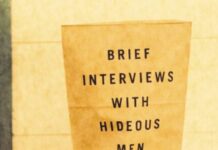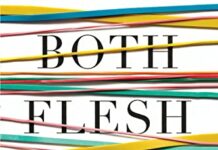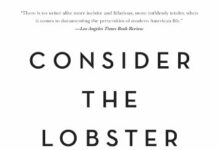
Ebook Info
- Published:
- Number of pages:
- Format: PDF
- File Size: 1.70 MB
- Authors: David Foster Wallace
Description
Published when Wallace was just twenty-four years old, The Broom of the System stunned critics and marked the emergence of an extraordinary new talent. At the center of this outlandishly funny, fiercely intelligent novel is the bewitching heroine, Lenore Stonecipher Beadsman. The year is 1990 and the place is a slightly altered Cleveland, Ohio. Lenore’s great-grandmother has disappeared with twenty-five other inmates of the Shaker Heights Nursing Home. Her beau, and boss, Rick Vigorous, is insanely jealous, and her cockatiel, Vlad the Impaler, has suddenly started spouting a mixture of psycho-babble, Auden, and the King James Bible. Ingenious and entertaining, this debut from one of the most innovative writers of his generation brilliantly explores the paradoxes of language, storytelling, and reality.
User’s Reviews
Reviews from Amazon users which were colected at the time this book was published on the website:
⭐I have been obsessed with David Foster Wallace because his writing is audacious, unique, and so linguistically creative. His dialogue rings true, although no one has any idea why because not all of his characters ring true (or are even supposed to). He has certain writing tics that we recognize with affection whenever we run into them. He is no longer with us, biologically speaking, but he is not gone either. I have managed to read DFW backwards for no reason that I am conscious of. I started with The Pale King, put together posthumously from notes and chapters found in his files after his untimely death. I have read through most of his work but not The Broom of the System. So last month, I finally downloaded The Broom of the System, that fateful first novel that Mr. Wallace published when he was just 24. And I can see that it is much less sophisticated than his later work but that signature audacity is there and perhaps is even stronger because not backed up by as much craft and life experience. It’s a bit of a heavy-handed light-hearted novel and although I have read the Wittgenstein comments from the critics and the Pynchon comparisons, and the post-modernist arguments, I did not come up when those writers or philosophies were the keys to literature, so I cannot look at DFW’s books in that way except through the eyes of others. I can see that the characters in The Broom of the System do tend to be a bit two dimensional and cartoonish but I don’t really mind; they still involve me. I swim my own way into and out of the various membranes that populate the novel, right down to the cellular level, the self and the other, the membranes essential to female virginity and the piercing of membranes necessary for pregnancy. Even the phones seem membranous. This is pure Wallace; biology is always going awry and even objects like buildings are biological. The phones in “Broom” are a nervous system; there are “lungs” under the tennis courts in Infinite Jest. Lenore Beadsman is our heroine and she has lost her paternal grandmother, also named Lenore Beadsman, who seems to have fostered a certain mindset in her granddaughter (brainwashed her) who visits her regularly in the nursing home. But Senior Lenore and about 25 residents and staff from the nursing home have disappeared and no one can find them. How will Grandma survive when she is so sensitive to cold that she can only exist in an environment that is 98.6 degrees Fahrenheit? (There’s that biology again.) Is there a parental separation story here perhaps? We make several digressions into Lenore (Juniors) past. In one we follow her to Mount Holyoke College where she goes to visit her older sister Claire and meets Wang Dang Lang and Biff Diggerance, whose gauche behavior makes her chose a more sheltered college to attend. We follow her to her job at Frequent and Vigorous, a publishing company where her boss, Rick Vigorous, quite a bit older than Lenore, is also her boyfriend, a boyfriend who cannot consummate the relationship, who tells odd stories to Lenore instead of making love to her, and who, even so, is very jealous. We visit her bird Vlad the Impaler with her when he, once a silent pet, becomes quite talkative. She learns from her father, owner of Stonecipheco Baby Food – competitor to Gerber – that there is a connection between the missing Senior Lenore and the newly precocious bird. Wallace loves to put in landscape features that are either ridiculous man-made constructs or that have resulted from our abuse of the environment, so we find that, although we are in Cleveland (Wallace has a Midwest connection), Lake Erie is filled with a brown, sort of gelatinous, sludge occasionally showing sort of brown waves with white tops. Another area of Cleveland has been turned into the Great Ohio Desert (G.O.D.), a touristy invitation to walk the black sands and eyeball carefully designed desert landscapes, and to perhaps meditate (it isn’t supposed to make literal sense). Then we find the political David Foster Wallace who had strong liberal leanings and who gives us the giant voracious Capitalist, Norman Bombardini, who is already grossly fat and yet wants to expand further and eat everything (especially Lenore Beadsman, the younger, who also happens to be one of DFW’s impossibly beautiful women who don’t know they are beautiful). The play of light and shadow has a role in this story and there is a “broom of the system”, but I will not elucidate. The excesses of DFW are given to us by him on purpose and are part of what makes my brain wake up just thinking about any one of his books. If you read The Broom of the System you can also meet Lenore’s younger brother, the Antichrist and you can learn to play “Hi Bob”, a killer college drinking game. David and I are probably done for now, but I could, given time, read these books again and find many new and interesting little baubles and I just might do that whenever I need to get my adrenalin flowing (which great literature always does).
⭐The Broom of the System is David Foster Wallace’s (1962-2008) first major work, an anti-novel, written in his early twenties while in English studies at Amherst College. The “Broom” represents a major theme for Wallace throughout his life–an antimony–a contradiction whose meaning/essence depends upon what it (the broom/antimony) is used for. The System represents the context (family/society/story/narrative) within which the Broom exists without which the Broom cannot and does not exist. At least that’s my interpretation. No one ever asked Wallace as far as I can find out. Wallace is reported to have said about Broom: “I am young and confused and obsessed with certain problems [that] … distill the experience of being human.” That would remain true of Wallace throughout his life even as he became less young. The problems’ David Wallace was obsessed with [as articulated in Broom, Infinite Jest (1996) and The Pale King (2011)] are: The Barber, The Road Runner, Words, Beautiful, big-breasted women, and the pleasure/pain nexus/dichotomy and the ineffectiveness of Authority to be authoritative (except to themselves – specifically – parents and their proxies, psychologists. All of the above are antinomies (Ironies) of a sort, or what I call The Double Bind: “Damned if you do and damned if you don’t.” “Can’t live with them, can’t live without them.”A closer look at a/the broom will shed some light, a little, on all this confusion. The archetypal guru in Broom tells her very, very, beautiful great grand-daughter that a broom can and is what it is only used for. It can be an implement to break a window or/and then, clean up the/a mess. Ten years hence, in Infinite Jest, the broom reappears as an object of love and affection for a burly, paranoid, Canadian Separatist who uses it to idly sweep his shop’s floors. (The man actually hand-made the broom himself.) At the conclusion of the scene, in graphic detail and beautiful prose (words), the broom is used to skewer and pin the man–down through his mouth and throat and so-on-and-so-forth until the broom’s shaved and sharpened pointed shaft emerges out his ass–to the floor of his shop … where he dies a hideous death (pg.482-489). The reappearance of ideas, thoughts, themes, scenes, etc. is a constant and can be counted on without doubt. Nothing, not one thing, is ever resolved in Wallace’s work. How about Death? That surely is finite. Yes? Wallace is obsessed with it, of course, and in Jest, through two separate characters, he suggests that Death is not at all an end. He says that a man is destined to fall in love with a woman who will kill him, and then, the dead lovers will both be reborn in a future life – she as a woman who will give birth to him, the murdered love, which then accounts for a mother’s obsessive protective instincts towards their sons. This scenario can go on infinitely but remain unknown to people except through dreams, which of course can drive a person crazy. The whole idea/thought that the only escape from the fear of death is in dying is omnipresent. This circular ruminating of Wallace’s he alludes to as “Marijuana thinking,” of which he admits to being under the spell of (Marijuana) in his late stage personality’s formative (15-25) years. “We can think only the things that can’t think themselves.” (BOTS, pg. 248). Love and trust go round and round in Wallace’s brain, too, with no apparent ever landing. In Jest: “… it would be like being able both to lie and to trust other people at the same time.” (pg.146 & see also pg. 136). And in Broom – The Barber – “who shaves all and only those who do not shave themselves.” (pg. 42). And finally, no of course not ever finally, The Road Runner (referenced i/r/t the TV show) `”Why doesn’t the coyote take the money he spends on bird costumes and catapults and radioactive road runner pellets and explosive missiles and simply go eat Chinese?”‘ (pg. 352). The answer to that question would solve a great many of humanity’s problems.Are you getting a sense of Wallace? The question is, as always it is, should YOU read this book. It is not for everyone (Understatement.) In fact, this book and all of Wallace’s work is for only and all who like antinomy and the anti-novel. Is that you? Are you highly open-minded and creative and very much highly intelligent … then you should definitely read David Foster Wallace. And I cannot tell you where to begin, but perhaps his commencement speech at Kenyon College “This is Water: Some Thoughts, Delivered on a Significant Occasion, about living a Compassionate Life,” (May 21, 2005) would be a good jumping off place. Wallace, I think, would lose sleep over the thought: “A thing is what it is and not something else.”May 21, 2011
⭐It feels like a Thomas Pynchon imitation – a very pale one at that. It tries too hard and lacks all the things that make Pynchon so interesting – overall, it is the literary equivalent of listening to a cousin’s precocious 11-year-old child at a Christmas lunch.
⭐I used it for entertainment. The story was very compelling.
⭐As good as all his books, therefore – brilliant.
⭐Fine
⭐This was David Foster Wallace’s first novel, written when he was 26. It is surreal, often achingly funny, and manages to incorporate devastating digs at a number of American shibboleths and institutions, especially the all-American family. DFW can riff on – for example – `vanity’ for 20 pages to devastating effect, making you cry, laugh and think harder than you’ve thought all week – enormously powerful and wonderful writing. However, in this debut fiction, there is a thin melange of plot, comic-book characters, psychological malignancy and stories within stories – it is not always a pleasant or easy read. What’s more there is none of the assurance of his magnum opus Infinite Jest. Lenore Beadsman is the daughter of a baby-food manufacturer, working as a telephonist for Frequent and Vigorous, a non-functioning publishing company which is funded as a tax-deduction. There are running jokes galore, including the one about the telephone exchange malfunction whereby Lenore mostly gets calls meant for a sado-masochism parlour. When Lenore’s grandma, also called Lenore, disappears from her nursing home, Lenore tries to find her. That’s about as much plot as you get, but plot is not the point. Lenore’s grandma studied with Wittgenstein and there are philosophical puzzles and an enormous amount of fun to be had with words. The label most often applied to DFW is “metafiction”. But here’s what DFW has to say about fiction – and his life: “Fiction is one of the few experiences where loneliness can be both confronted and relieved. Drugs, movies where stuff blows up, loud parties — all these chase away loneliness by making me forget my name’s Dave and I live in a one-by-one box of bone no other party can penetrate or know. Fiction, poetry, music, really deep serious sex, and, in various ways, religion — these are the places (for me) where loneliness is countenanced, stared down, transfigured, treated.”
Keywords
Free Download The Broom of the System: A Novel in PDF format
The Broom of the System: A Novel PDF Free Download
Download The Broom of the System: A Novel PDF Free
The Broom of the System: A Novel PDF Free Download
Download The Broom of the System: A Novel PDF
Free Download Ebook The Broom of the System: A Novel




